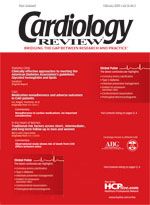Case report: Combination therapy for metabolic syndrome
Case report: Combination therapy for metabolic syndrome
A 62-year-old man had a history of hypertension and dyslipidemia. He had never smoked, walked regularly, and watched his diet; however, he had a family history of premature myocardial infarction. His medications included hydrochlorothiazide, 50 mg/day; atenolol, 100 mg/day; and simvastatin, 20 mg/day. On physical examination, his blood pressure was 122/76 mm Hg, his height was 5’10”, and his weight was 190 lb (BMI, 27.3). The rest of the physical examination was normal. A fasting lipid profile showed the following values: total cholesterol, 185 mg/dL; low-density lipoprotein (LDL) cholesterol, 112 mg/dL; high-density lipoprotein (HDL) cholesterol, 34 mg/dL; and triglycerides, 178 mg/dL. The lipoprotein (a) level was 32 mg/dL (normal, < 30 mg/dL), and the fasting blood glucose level was normal.
Like many patients, this man had multiple coronary artery disease (CAD) risk factors and metabolic syndrome as a result of his dyslipidemia, hypertension, and severe overweight. His 10-year Framingham CAD risk was 16%, placing him at moderately high risk. Based on the Adult Treatment Panel (ATP) III of the National Cholesterol Education Program, his LDL cholesterol level was below the minimum goal of less than 130 mg/dL; however, in the recent ATP III update, an optional goal of less than 100 mg/dL has been recommended. He also had many other lipid abnormalities, including low HDL cholesterol, increased triglycerides, and increased lipoprotein (a) levels.
After normal results were obtained on a stress test, the patient was counseled about the importance of a heart-healthy lifestyle, emphasizing diet, exercise, and weight loss. Successful lifestyle changes can significantly improve multiple risk factors, allowing reduction and possibly withdrawal of some medications in the long term. Doubling the dose of a statin generally results in an additional 6% reduction in LDL cholesterol, with lesser effects on other lipid parameters. To achieve this patient’s composite lipid targets, the simvastatin was discontinued, and niacin ER/lovastatin was gradually titrated to a dose of 2,000/40 mg once daily at bedtime. An aspirin, 30 minutes prior to dosing, was also added to the regimen to limit flushing and for CAD prevention.
At follow-up, his lipid panel showed good control of all lipid parameters: LDL cholesterol, 94 mg/dL; HDL cholesterol, 42 mg/dL; triglycerides, 145 mg/dL; and lipoprotein (a), 27 mg/dL. The niacin ER/lovastatin was well tolerated, with some initial flushing but no myalgia or increases in fasting blood glucose, creatine kinase, or liver function levels. This case shows the advan-
tages of combination therapy in controlling multiple lipid abnormalities compared with statin therapy alone in a patient with the metabolic syndrome. n
